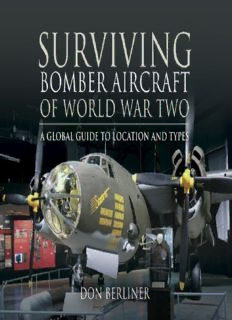
Surviving Bomber Aircraft of World War Two PDF
Preview Surviving Bomber Aircraft of World War Two
First published in Great Britain in 2012 by Pen & Sword Aviation An imprint of Pen & Sword Books Ltd 47 Church Street Barnsley South Yorkshire S70 2AS Copyright © Don Berliner 2012 9781783830510 The right of Don Berliner to be identified as Author of this work has been asserted by him in accordance with the Copyright, Designs and Patents Act 1988. A CIP catalogue record for this book is available from the British Library All rights reserved. No part of this book may be reproduced or transmitted in any form or by any means, electronic or mechanical including photocopying, recording or by any information storage and retrieval system, without permission from the Publisher in writing. Typeset in 10.5pt Palatino by Mac Style, Beverley, East Yorkshire Printed and bound in India by Replika Press Pvt. Ltd. Pen & Sword Books Ltd incorporates the Imprints of Pen & Sword Aviation, Pen & Sword Family History, Pen & Sword Maritime, Pen & Sword Military, Pen & Sword Discovery, Wharncliffe Local History, Wharncliffe True Crime, Wharncliffe Transport, Pen & Sword Select, Pen & Sword Military Classics, Leo Cooper, The Praetorian Press, Remember When, Seaforth Publishing and Frontline Publishing For a complete list of Pen & Sword titles please contact PEN & SWORD BOOKS LIMITED 47 Church Street, Barnsley, South Yorkshire, S70 2AS, England E-mail: [email protected] Website: www.pen-and-sword.co.uk Table of Contents Title Page Copyright Page Introduction Chapter 1 - United States of America Chapter 2 - Great Britain Chapter 3 - Union of Soviet Socialist Republics Chapter 4 - Germany Chapter 5 - Italy Chapter 6 - Japan Appendix - Extinct World War Two Bomber Types Introduction Combat aviation in World War Two was really about bombers. Fighters were unquestionably the glamour airplanes. The Spitfires and Messerschmitts and Mustangs were the fastest and the most maneuverable, and their pilots were the modern counterparts of daring, flamboyant cavalrymen. But fighters were used primarily to destroy enemy bombers before they could accomplish their destructive missions, and to prevent enemy fighters from destroying their own air force’s bombers. As the war progressed, fighters became fighter-bombers, taking on some of the characteristics of bombers, with shackles under their wings that could carry hundreds and then thousands of pounds of bombs. In order to make this work, the fighter pilot had to accept the role of bombardier, in addition to the those of navigator, radioman and gunner, for which he might not have been so thoroughly trained. Vital as they were, all other types of aircraft had to take a back seat to the bombers. Trainers existed to prepare pilots and aircrew for their primary missions. Transports delivered men and materiel to where they were needed. Reconnaissance airplanes found the targets for the bombers and the fighter-bombers, and then brought back enough information to enable analysts to determine the effectiveness of the bombing missions. Most major air forces included the same broad sub-categories of bombers: attack, light, medium and patrol. But only the Royal Air Force and US Army Air Forces saw the need for thousands of four- engined heavy and very heavy bombers. They took the war directly to the enemy’s homes and factories, and it was the lack of such long- range deliverers of bombs in the Luftwaffe that constituted one of the major, history-changing blunders on the part of the leaders of the Third Reich. While much of the pre-war thinking about air warfare pointed to such bombers being unstoppable, the initial inability to provide them with fighter protection revealed the serious susceptibility of even the most heavily-gunned bombers to an organized attack by a swarm of enemy interceptors. It wasn’t until the development of the long-range single-seat fighter capable of accompanying bombers on their longest missions, did it become feasible to send great formations deep into enemy territory in broad daylight. In the final accounting, it was the bombers’ ability to significantly interfere with the production of equipment and vital parts, such as ball bearings, that so reduced the war-making potential of both Germany and Japan, thus shortening the war and saving many thousands of lives. Inevitably, there are a few bombers whose exact categorization has been impossible to ascertain. Is a ‘reconnaissance bomber’ a reconnaissance airplane or a bomber? What of a bomber that was withdrawn from combat during the war and used for training bomber pilots? As was the case with fighters in Volume I, the World War Two types display an amazing range of technology. There was progress in just a few years from those with open cockpits, fixed landing gears and piston engines of a few hundred horsepower, to the Arado Ar.234 Blitz with four jet engines, and the Fieseler Fi 103 ‘buzz bomb’, which lacked a human pilot.
Description: